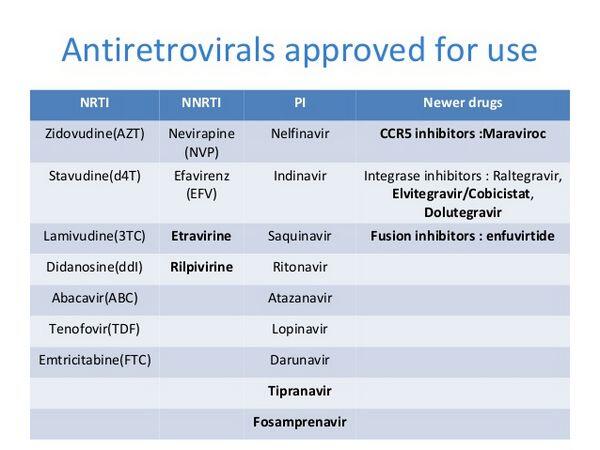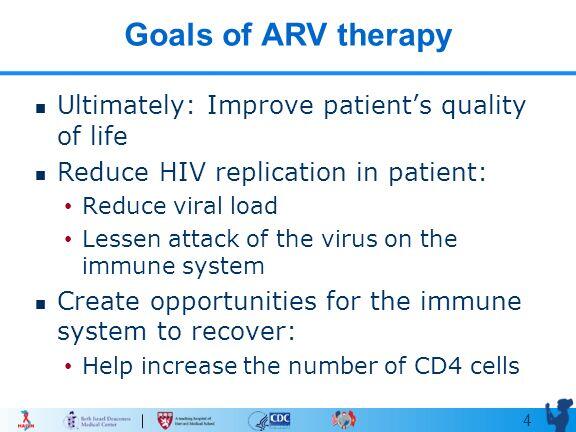Therapeutic options for the management of HIV infection have increased, and recommendations concerning the use of antiretroviral agents in the treatment of the disease have changed over the last several years because of expanded knowledge concerning the immunopathogenesis of HIV, the availability of several different classes of antiretroviral agents (nucleoside reverse transcriptase inhibitors [NRTIs] , HIV protease inhibitors, nonnucleoside reverse transcriptase inhibitors [NNRTIs], nucleotide reverse transcriptase inhibitors, HIV fusion inhibitors), and improvements in laboratory methods used to evaluate the rate of disease progression and response to antiretroviral therapy.

Effective management of the disease must be based on updated information related to the biology and pathogenesis of HIV infection, currently available antiretroviral agents, clinical status of the patient.
The general principles of antiretroviral therapy are summarized below.

- The goal of antiretroviral treatment of HIV infection should be to maintain immune function in as near a normal state as possible, prevent disease progression, prolong survival, and preserve quality of life by effectively suppressing HIV replication. To accomplish this, antiretroviral therapy should be initiated before significant immune system damage occurs whenever possible. Active replication of HIV is the cause of progressive immune system damage in HIV-infected individuals. In the absence of effective inhibition of HIV replication by antiretroviral therapy, nearly all infected individuals will suffer progressive deterioration of immune function resulting in susceptibility to opportunistic infections, malignancies, neurologic diseases, and wasting, ultimately leading to death.
- Regular periodic measurement of both plasma HIV-1 RNA levels and CD4+ T-cell counts in HIV-infected individuals is necessary to determine the risk of disease progression and guide decisions regarding when to initiate or modify antiretroviral regimens. The rate of progression of HIV disease is predicted by the magnitude of active HIV replication occurring in an infected individual, and this replication is indicated by viral load as measured by plasma HIV-1 RNA levels. The extent of immune system damage that has already occurred is indicated by the CD4+ T-cell count.
- Treatment decisions regarding antiretroviral therapy should be individualized based on severity of disease at baseline as assessed by plasma HIV-1 RNA levels and CD4+ T-cell counts. Potential adverse drug reactions and drug interactions; coexisting conditions (e.g., mycobacterial infections, liver disease, cardiovascular disease, mental illness, drug or alcohol abuse, pregnancy or family planning issues); and patient preference regarding pill burden, dosing frequency, and food and fluid requirements also should be considered.
- Maximal suppression of HIV replication usually is the goal of antiretroviral therapy. Use of potent multiple-drug antiretroviral regimens to suppress HIV replication to below the limits of detection of sensitive plasma HIV-1 RNA assays may delay or prevent selection of antiretroviral-resistant HIV variants; resistance is the major factor limiting the ability of antiretroviral agents to inhibit virus replication and delay disease progression.
- Whenever possible, therapy should be initiated (or modified) with a rational multiple-drug antiretroviral regimen and a predefined target for the degree of suppression of HIV replication. The most effective means to accomplish durable suppression of HIV replication is the simultaneous initiation of a multiple-drug regimen that includes active antiretrovirals.
- Multiple-drug antiretroviral therapy should be initiated with all drugs started simultaneously (ideally within 1 or 2 days of each other) and maintained at recommended dosages whenever possible. Incomplete suppression of HIV replication may result in development of resistance; resistance to antiretrovirals is less likely to occur if underdosing or irregular dosing is avoided.
- The same principles of antiretroviral therapy that apply to adults also apply to HIV-infected children and adolescents, although the treatment of HIV-infected children involves unique pharmacologic, virologic, and immunologic considerations.
- Women should receive optimal antiretroviral therapy regardless of pregnancy status.
- Individuals with primary (acute) HIV infection should be treated with multiple-drug antiretroviral regimens to suppress virus replication to levels below the limits of detection of sensitive plasma HIV-1 RNA assays. Antiretroviral therapy during primary infection may serve to preserve immune system function by blunting the high level of HIV replication and immune system damage that occurs during this period and potentially reduces set-point levels of HIV replication.
- All HIV-infected individuals (even those with viral loads below the limits of detection) should be considered infectious and should be counseled to avoid sexual and drug-use behaviors associated with transmission or acquisition of HIV and other infectious pathogens. Data are insufficient to date to determine whether HIV-infected individuals whose viral load has been reduced to undetectable levels through antiretroviral therapy are able to transmit the infection to others.






